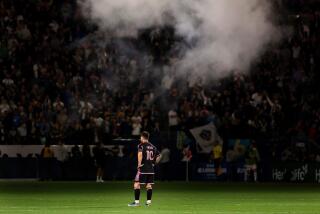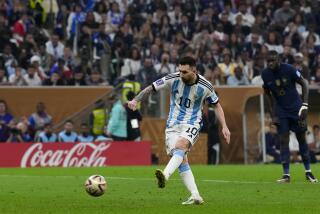Maradona Still Thrills Argentina
HERZOGENAURACH, Germany — Argentinian soccer remains the Diego Maradona Show.
Regarded by some as the game’s greatest player, Argentina’s legendary No. 10 pops up unannounced at the country’s World Cup practices in northern Bavaria, often puffing on an oversized Cuban cigar as he struts in and out of the team hotel with his estranged wife and their daughter.
At Argentina’s first-round matches, he upstaged Coach Jose Pekerman with pregame pep talks for players young enough to be his sons.
One of them, 18-year-old striker Lionel Messi, has been dubbed the “next Maradona.” He had yet to be born when Maradona led Argentina to its second World Cup title in 1986.
“Maradona inspires us, and he gets our greatest respect,” said Carlos Tevez, a 22-year-old striker who, like Maradona, grew up in a Buenos Aries shantytown. Stocky, with black curly hair, Tevez looks like Maradona and shares some of his playing style: swaying hips, low center of gravity, a bull-like ferocity.
“He’s our idol, and an idol for the people,” added Tevez, who also was billed as the “next Maradona” until Messi came along. “Every time he shows up he makes us laugh a lot, and when he leaves we feel we are stronger than we really are.”
A beat-up white Volkswagen often parks at Argentina’s practice field, a message scribbled on its side:
“The Pope is German. God is Argentine -- Diego X.”
A few steps from where the car parks, near a closed gate blocking the training ground entrance, 22-year-old Ignacio Anselmo pulls up his blue Argentina shirt to show off three tattoos -- all inspired by Maradona.
His Buenos Aires friend, Federico D’Andrea, rolls up his right sleeve to display another Maradona image on his shoulder.
“Are you going to write something good or bad about him?” Anselmo asked.
“In Argentina, football is everything, and he is everything,” Anselmo explained. “It’s everything he has done in 30 years, not just the ’86 World Cup. The negative things about him aren’t important; those are his personal things.”
The 25-year-old D’Andrea said he spent about $1,500 to fly from Argentina to Germany. He echoed his friend: “Maradona is the biggest in soccer history. It’s a simple as that.”
Maradona used to be known as “El Peluza,” literally “lint” in Spanish and a word used to describe poor street kids. Now he’s more often called “El Pibe de Oro” -- the Golden Boy.
At 45, Maradona is a survivor.
He was near death on a respirator two years ago after suffering a heart attack attributed to a cocaine overdose. He says he’s been clean since, had a gastric bypass to lose weight, and last year his Argentine talk show, “La Noche del 10” (The Night of the No. 10), soared to unexpected popularity.
His TV career has continued at the World Cup, where he is providing commentary on games for a small Spanish station, La Cuatro.
“The whole world recognizes Maradona as a legendary soccer player,” said La Cuatro spokesman Jose Enrique Melendez, who said Maradona was signed “at no doubt considerable cost.”
Maradona has pulled a few fast ones in his time. Some liken him to the classic “picaro” character of 16th century Spanish literature, the rascal who lives by his wits and seeks every advantage.
In a 2-1 quarterfinal victory over England in the 1986 World Cup, Maradona scored one goal after touching it with his hand. The referee didn’t spot it. He scored another four minutes later, weaving by five English players and then beating goalkeeper Peter Shilton. That goal was voted the greatest of the 20th century, but the English still believe Maradona cheated them.






